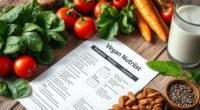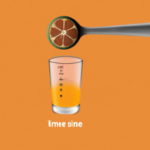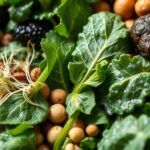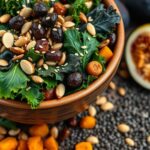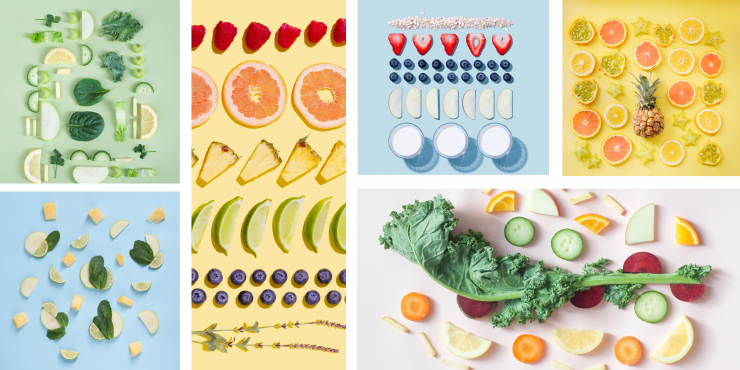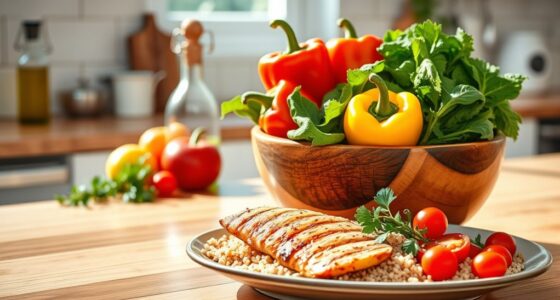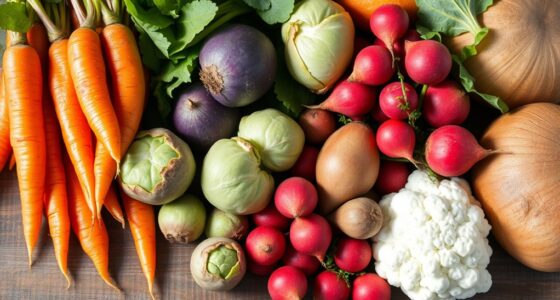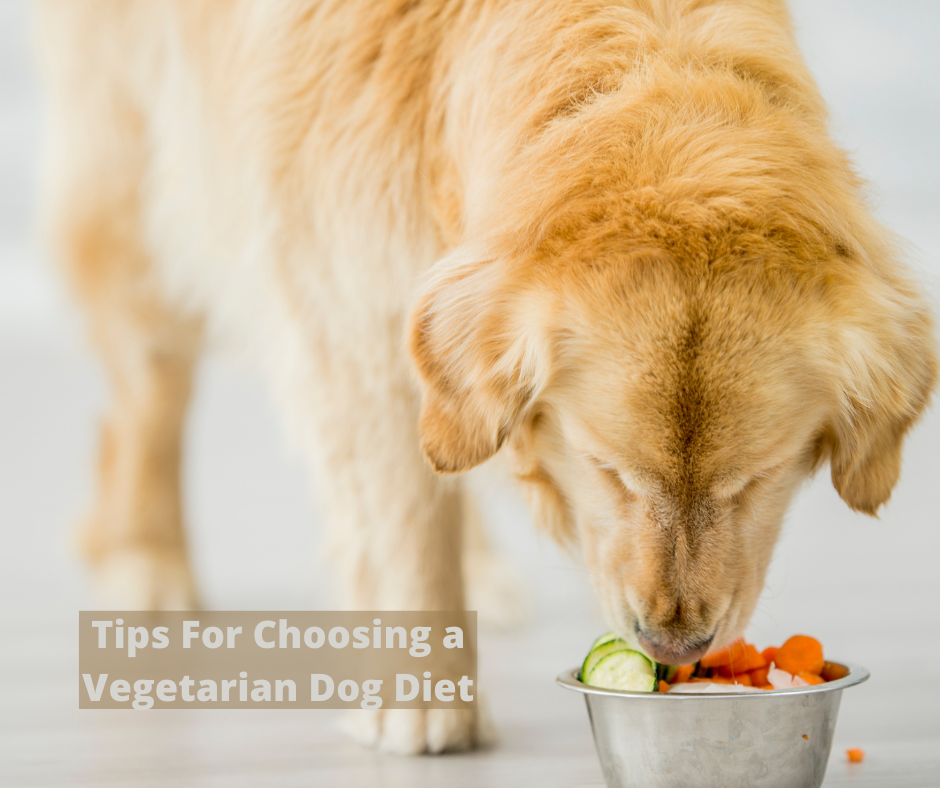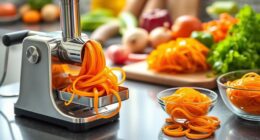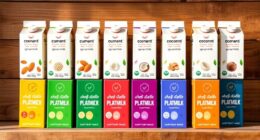To boost your iron intake, include plant-based foods like leafy greens, legumes, quinoa, nuts, and seeds, which are rich in non-heme iron. Pair these with vitamin C-rich fruits or vegetables, such as citrus or bell peppers, to enhance absorption. Avoid high-calcium foods and tannins during meals, and use cooking methods like soaking, sprouting, or cooking in cast iron pots. For effective strategies and tips, there’s more to discover below.
Key Takeaways
- Incorporate plant-based sources like spinach, tofu, quinoa, and fortified cereals, pairing them with vitamin C-rich foods to enhance iron absorption.
- Prepare legumes and grains by soaking, sprouting, or cooking thoroughly to reduce phytates that inhibit iron bioavailability.
- Consume vitamin C sources such as citrus fruits, bell peppers, and tomatoes alongside iron-rich foods to convert non-heme iron into more absorbable forms.
- Limit calcium-rich foods, tannins, and polyphenols during meals, and add vitamin C at meal end to maximize iron uptake.
- Use cast iron cookware, include nuts, seeds, and dried fruits in meals, and combine with vitamin C foods for optimal plant-based iron absorption.
Top Plant-Based Sources of Iron
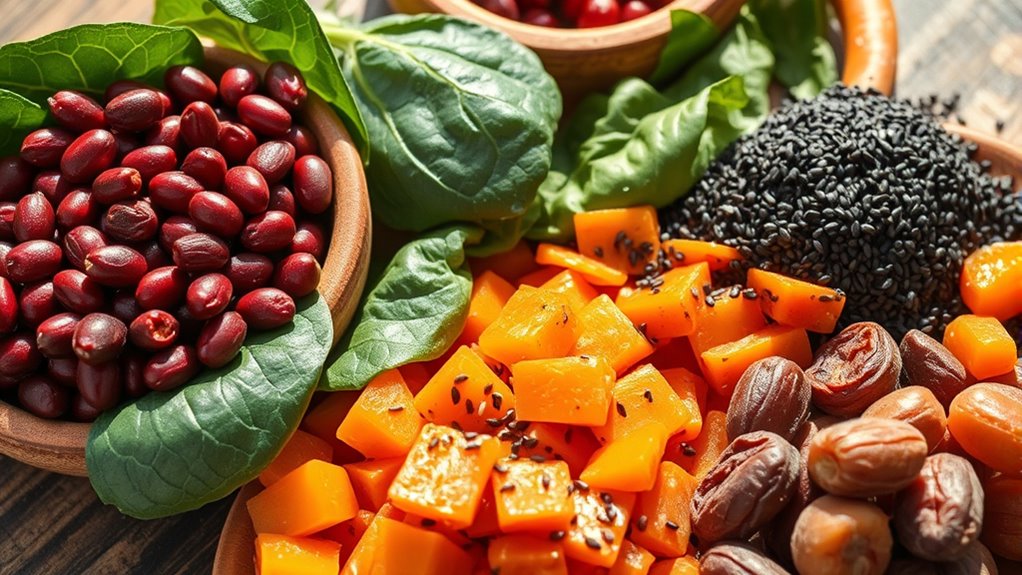
Are you looking to boost your iron intake through plant-based foods? If so, focus on top sources like spinach, Swiss chard, tofu, quinoa, pumpkin seeds, and fortified cereals. While these foods are rich in iron, keep in mind that iron bioavailability can vary, affecting how well your body absorbs it. Plant-based supplementation often involves consuming iron-rich foods alongside vitamin C sources, which enhances absorption. For example, pairing leafy greens with citrus or bell peppers boosts iron bioavailability markedly. Remember, plant foods contain non-heme iron, which is less readily absorbed than animal-based heme iron, so strategic combinations are key. Incorporating these iron sources regularly to support your nutritional needs and maximize absorption efficiently can also involve choosing foods that contain antioxidants, which may help improve overall mineral utilization. Additionally, considering food preparation methods, like soaking or sprouting, can reduce inhibitors and further enhance mineral absorption. Including foods rich in vitamin C alongside iron sources is another effective way to increase absorption, making your plant-based iron intake more efficient.
Legumes and Pulses: Iron Powerhouses
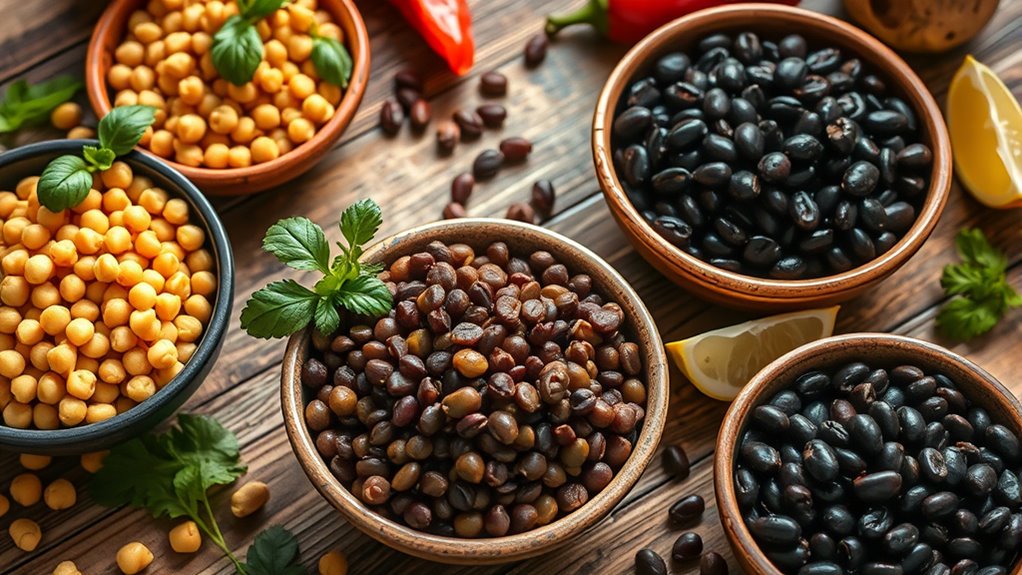
Legumes and pulses are among the best plant sources of iron, making them essential for your vegetarian diet. To maximize iron absorption, pair them with vitamin C-rich foods and soak or cook them properly. Using the right cooking methods can boost their nutritional benefits and help you get the most iron from these foods. Being aware of potential allergy risks associated with certain seeds and legumes can also help you make safer dietary choices. Additionally, selecting safe food handling practices ensures that you reduce the risk of contamination and adverse reactions. Proper food preparation techniques can further enhance nutrient bioavailability, ensuring you gain maximum benefits from your vegetarian iron sources. Understanding the importance of Gold IRA regulations can also guide you in making informed choices about your investments.
Iron Content in Legumes
Because they are rich in iron, legumes and pulses serve as essential plant-based sources for vegetarians looking to boost their iron intake. The iron content varies among different legumes, but many provide significant amounts per serving. To maximize iron bioavailability, proper legume preparation is vital. Here are key points to consider:
- Cooking methods like soaking and boiling help reduce phytates that inhibit iron absorption.
- Soaking legumes overnight can decrease anti-nutrients, increasing iron bioavailability.
- Sprouting legumes further reduces inhibitors and boosts nutrient absorption.
- Pairing legumes with vitamin C-rich foods enhances iron absorption, making your efforts more effective.
Understanding these factors guarantees you get the most nutritional benefit from legumes, making them a potent part of your iron-rich vegetarian diet.
Enhancing Iron Absorption
To maximize the iron benefits from legumes and pulses, pairing them with vitamin C-rich foods is essential, as this combination considerably enhances iron absorption. Vitamin C increases iron bioavailability by converting plant-based non-heme iron into a more absorbable form, making it easier for your body to utilize. Be mindful of dietary inhibitors like tannins, calcium, and polyphenols, which can reduce iron absorption when consumed in large amounts. To optimize absorption, consume vitamin C sources such as citrus fruits, bell peppers, or tomatoes alongside your legumes and pulses. Avoid combining them with high-calcium foods or drinks like dairy or tea during meals, as these can impair iron uptake. By balancing these factors, you ensure your vegetarian diet delivers maximum iron benefits efficiently.
Best Cooking Practices
Cooking methods can substantially influence the iron content and absorption potential of legumes and pulses. To maximize benefits, consider these best practices:
- Use cast iron cookware, which can add iron to your food.
- Soak and sprout legumes before cooking to reduce phytates that hinder iron absorption.
- Incorporate seasoning strategies like adding vitamin C-rich ingredients (bell peppers, tomatoes) to boost absorption.
- Avoid overcooking, as excessive heat can degrade nutrients, but guarantee legumes are tender enough for digestibility.
- Understanding projector technology can help optimize cooking environments by controlling lighting conditions, enhancing visibility and precision during meal prep. Additionally, employing proper nutritional knowledge can guide you in combining foods effectively to improve mineral bioavailability.
Choosing the right cookware and seasoning strategies can markedly enhance iron intake from legumes. Pay attention to preparation techniques that liberate their full nutritional potential, making your vegetarian meals both delicious and iron-rich.
Dark Leafy Greens for Iron Boost
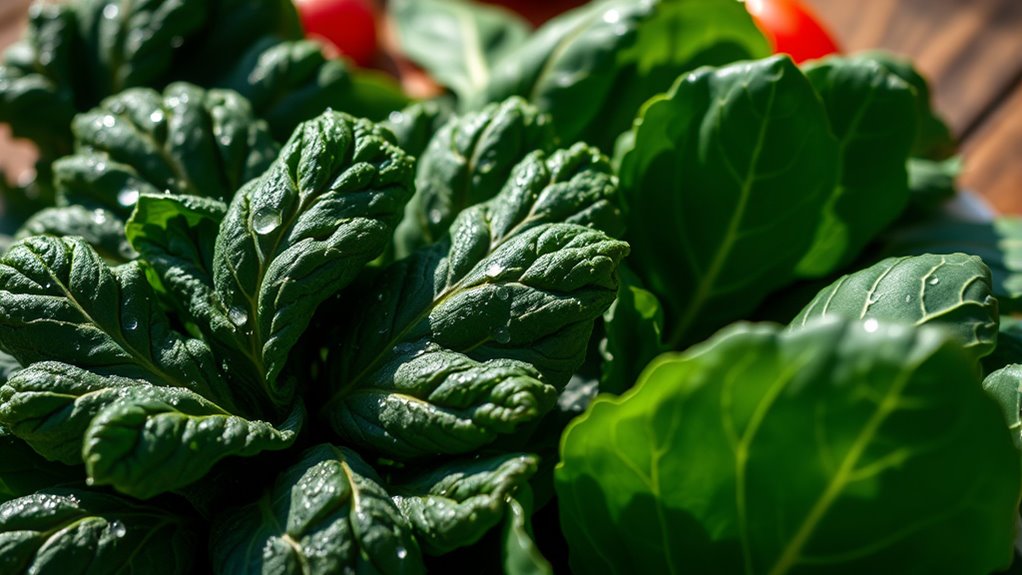
Dark leafy greens are some of the most nutrient-dense plant-based sources of iron, making them an excellent addition to a vegetarian diet. Leafy greens like spinach, kale, and collard greens provide non-heme iron, which can boost your intake. To maximize iron absorption, pair these greens with vitamin C-rich foods such as citrus or bell peppers. Cooking leafy greens reduces oxalate levels that can inhibit iron absorption, making the iron more bioavailable. Be mindful that certain compounds in greens, like oxalates, can interfere with absorption, so rotating greens and combining them with vitamin C helps. Incorporating a variety of leafy greens regularly ensures you get enough iron while supporting overall health. Additionally, understanding the WWE Raw’s Financial Impact can give insights into how large-scale entertainment ventures influence global markets and consumer habits. Recognizing the outdoor living and design trends can inspire creative ways to prepare and serve greens in a welcoming setting.
Whole Grains and Fortified Foods
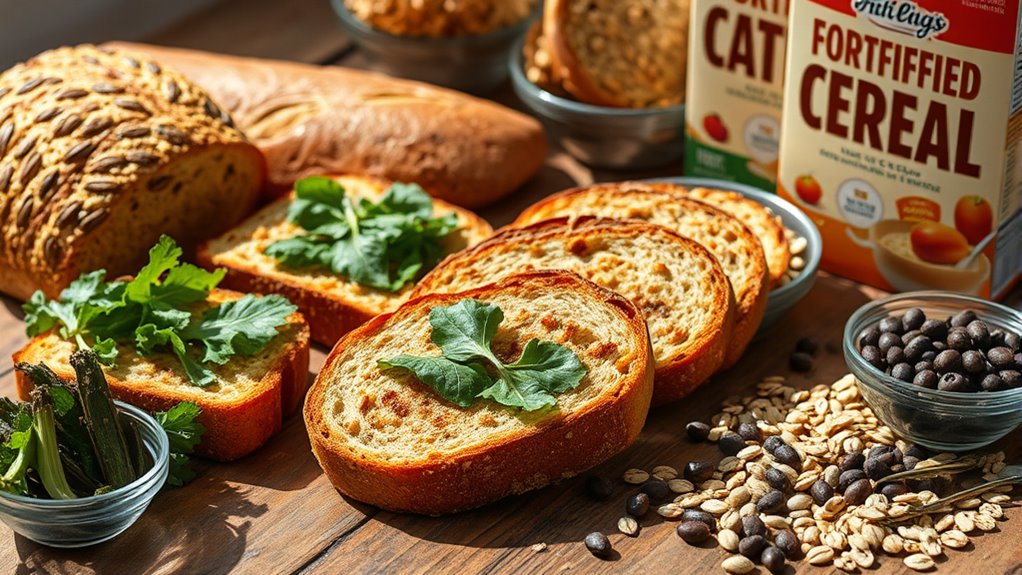
Whole grains and fortified foods are excellent ways to increase your iron intake on a vegetarian diet. Incorporate a variety of options to maximize absorption and nutritional value. Fortified cereals are an easy, convenient source—look for those with added iron. Whole grain varieties like brown rice, quinoa, and whole wheat bread also contribute considerably. To boost absorption, consider these tips:
- Choose cereals fortified with iron regularly.
- Mix different whole grains for nutritional diversity.
- Pair these foods with vitamin C-rich fruits or vegetables.
- Limit consumption of tea or coffee during meals, as tannins can hinder iron absorption.
- Incorporating a diverse range of fortified foods can help meet your iron needs more effectively.
Nuts, Seeds, and Dried Fruits
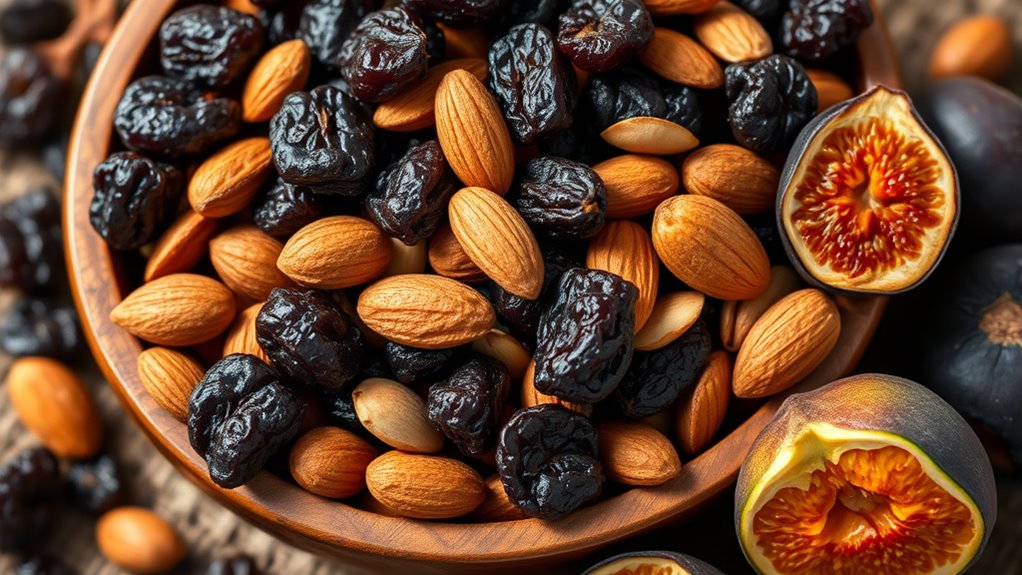
Are nuts, seeds, and dried fruits effective ways to boost your iron intake? Absolutely. Nuts and seed combinations, like almonds with pumpkin seeds, provide a good source of non-heme iron, especially when eaten regularly. Dried fruit pairings, such as apricots or raisins, are portable and easy to incorporate into your diet. Combining dried fruits with nuts or seeds enhances both flavor and nutrient absorption. For example, trail mixes with dried cranberries and sunflower seeds create a tasty, iron-rich snack. Keep in mind, while these foods contain iron, their absorption can be limited. To maximize benefits, pair them with vitamin C-rich foods later in your meals. Incorporating a variety of nuts, seeds, and dried fruits can help you meet your vegetarian iron needs effectively. Understanding bank SWIFT/BIC codes can also be useful if you’re transferring money internationally to support your health goals. Additionally, being aware of iron absorption factors can help you optimize your diet for better iron uptake. Incorporating anti-inflammatory foods can also support overall nutrient absorption and health.
Enhancing Iron Absorption With Vitamin C
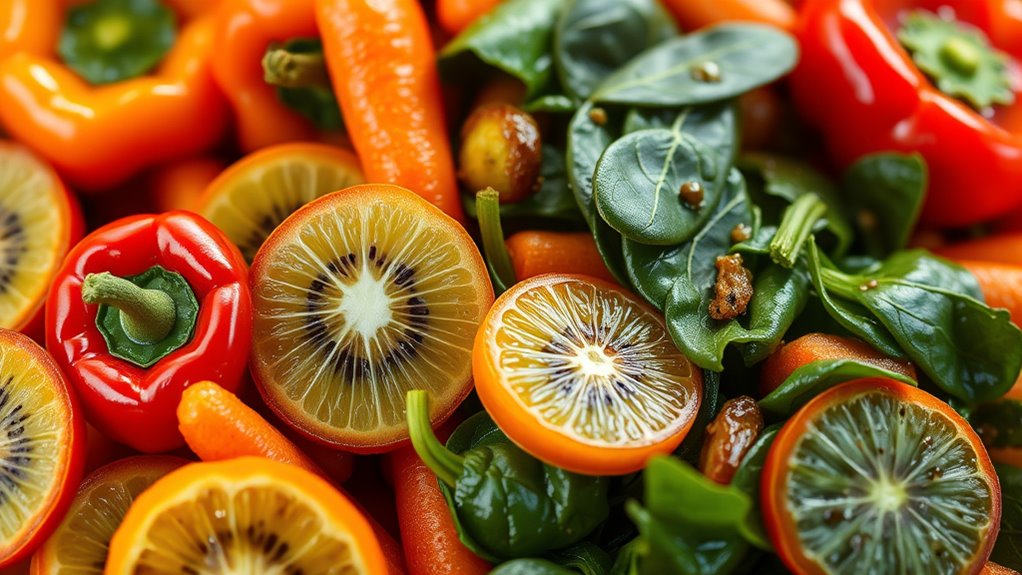
You can boost iron absorption by eating vitamin C-rich foods alongside your plant-based meals. Pair citrus fruits or bell peppers with your iron sources for better absorption, and try cooking techniques like steaming or roasting to preserve vitamin C content. These simple steps make it easier for your body to utilize the iron in vegetarian foods. Incorporating nutritional strategies like using performance-enhancing ingredients can further support your health goals. Additionally, selecting space-efficient appliances can help maximize your kitchen’s efficiency for preparing these nutrient-rich meals. Using mindful eating practices, such as eating slowly and savoring your food, can also improve nutrient absorption and overall digestion. Incorporating tableware that is both functional and attractive can also enhance your dining experience while ensuring proper portion control and presentation.
Vitamin C Role
Vitamin C plays an essential role in boosting iron absorption from plant-based foods. Without enough vitamin C, your body struggles with absorption strategies to combat iron deficiency. To maximize absorption, focus on these key points:
- Consume vitamin C-rich foods alongside iron-rich vegetarian sources.
- Pair leafy greens or legumes with bell peppers or tomatoes.
- Include citrus fruits or berries in your meals when possible.
- Avoid drinking tea or coffee immediately after eating, as they hinder iron absorption.
- Using self watering plant pots can help maintain optimal soil moisture, ensuring that your plants stay healthy and vigorous, which is especially beneficial when growing vitamin C-rich vegetables.
Citrus Pairings
Pairing citrus fruits with iron-rich vegetarian foods markedly boosts your body’s ability to absorb non-heme iron. Fruit pairings like oranges, grapefruits, and lemons provide a high dose of vitamin C, which enhances iron absorption when eaten together. To maximize benefits, consider timing your meals so that citrus is included during or immediately after consuming iron-rich foods. This ensures vitamin C is present in your digestive system when iron absorption occurs. Incorporate citrus into salads, smoothies, or as a side to boost iron uptake naturally. Remember, consistent pairing of citrus with plant-based iron sources substantially improves your body’s ability to utilize iron effectively, helping prevent deficiencies. Pay attention to meal timing to optimize this absorption process.
Cooking Techniques
Cooking techniques can considerably enhance iron absorption by preserving or increasing vitamin C content in your meals. To maximize vitamin C, consider these strategies:
- Use gentle cooking methods like steaming or sautéing instead of boiling, which can leach nutrients.
- Apply seasoning techniques that include adding fresh bell peppers, tomatoes, or citrus during cooking, boosting vitamin C levels.
- Store vegetables properly—refrigerate and keep them in airtight containers—to minimize nutrient loss.
- Add vitamin C-rich ingredients at the end of cooking to prevent heat degradation.
Tips to Maximize Your Iron Intake
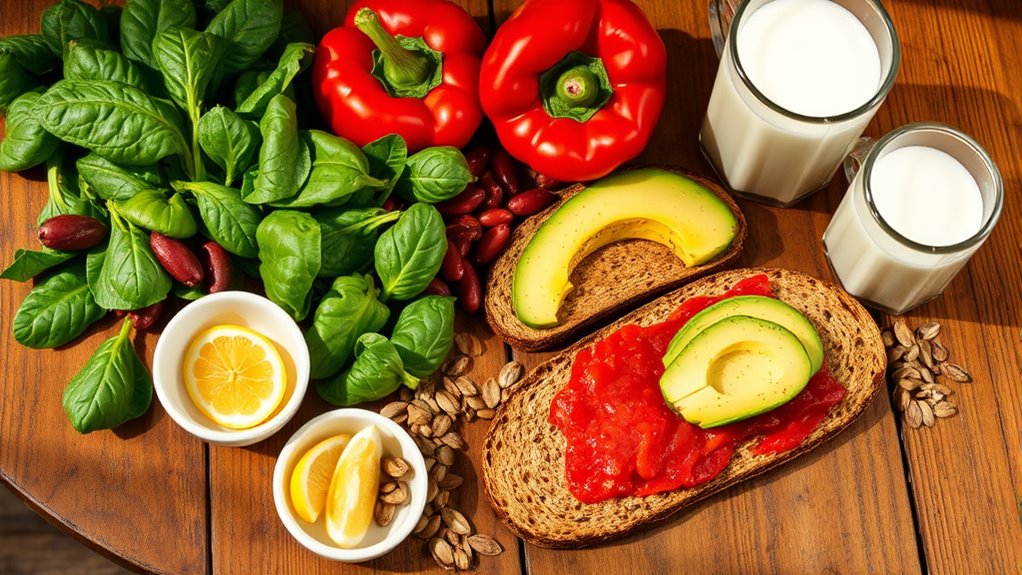
To maximize your iron absorption from vegetarian foods, it’s important to combine iron-rich plant sources with ingredients that enhance absorption. Iron deficiency is common among vegetarians, but you can improve absorption by pairing foods like spinach, lentils, or quinoa with vitamin C-rich ingredients such as citrus fruits, bell peppers, or tomatoes. These absorption enhancers help convert non-heme iron into a form your body can more easily use. Avoid drinking tea or coffee during meals, as tannins can hinder iron absorption. Instead, opt for a glass of orange juice or add lemon to your salads. Additionally, soaking, sprouting, or fermenting your grains and legumes can reduce phytates that block iron absorption. Following these tips ensures you get the most iron from your vegetarian diet.
Frequently Asked Questions
Can Vegans Get Enough Iron Without Supplements?
You can get enough iron on a vegan diet, but it takes mindful planning. Plant-based iron sources like beans, lentils, tofu, and spinach help meet your needs. To maximize absorption, pair these foods with vitamin C-rich options like citrus or peppers. While supplements aren’t always necessary, monitoring your iron levels through regular check-ups can guarantee your vegan nutrition supports your health without relying solely on supplements.
Are There Any Side Effects From Consuming High-Iron Plant Foods?
Consuming high-iron plant foods can sometimes lead to side effects like iron overload, which may cause fatigue, joint pain, or organ issues if unchecked. You might also experience gastrointestinal issues such as constipation, nausea, or stomach cramps. It’s important to monitor your intake and consult with a healthcare professional if you notice symptoms or have concerns about iron levels. Balancing your diet helps prevent these potential side effects.
How Do Cooking Methods Affect Iron Content in Plant Foods?
Cooking methods can markedly impact the iron content in plant foods. Boiling, for example, may cause cooking loss, reducing the mineral’s overall amount. On the other hand, steaming or pressure cooking helps retain more iron. Additionally, certain techniques improve mineral bioavailability; for instance, soaking or fermenting can decrease phytates that inhibit iron absorption. So, choose your cooking methods wisely to maximize iron intake from plant foods.
Is Iron From Plant Sources as Easily Absorbed as From Animal Products?
Plant-based iron presents penetration problems, as bioavailability issues hinder its absorption compared to animal products. While plant-based iron is plentiful, your body struggles to absorb it efficiently due to compounds like phytates and polyphenols. You can counteract this by combining iron-rich foods with vitamin C sources, which boost bioavailability. So, although plant-based iron is plentiful, you need to navigate bioavailability issues to maximize absorption effectively.
What Are Signs of Iron Deficiency to Watch For?
You should watch for deficiency indicators like fatigue, weakness, and pale skin, which are common symptoms of iron deficiency. You might also notice shortness of breath, dizziness, or cold hands and feet. Recognizing these signs early helps in symptom recognition and prompts you to seek medical advice. If you experience any of these, it’s important to check your iron levels to prevent further health issues.
Conclusion
By choosing plant-based iron sources, by pairing foods with vitamin C, and by staying consistent, you can boost your iron levels naturally. Embrace the variety, enjoy the vibrant colors, and feel empowered with every meal. Take control of your health, nourish your body, and fuel your energy. Remember, small choices create big changes—so make each meal a step toward stronger, healthier you. Keep nourishing your body, keep loving your journey, and keep thriving.
Aurelia is the Editor-in-Chief of The Graceful Kitchen, a vegan lifestyle blog that focuses on delicious, nutritious, and ethical eating. A lifelong vegan, Aurelia is passionate about sharing her love of plant-based cuisine with others. She is a regular contributor to several online and print publications, and has been interviewed by major news outlets about the benefits of a vegan diet. In her free time, Aurelia enjoys cooking, hiking, and spending time with her cats.

